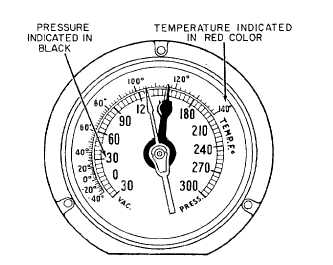the condenser to condense the amount of refrigerant
vapor coming from the compressor. The quantity of
water required to condense a given amount of
refrigerant varies with the water temperature. Thus, the
flow of cooling water through the condenser is
automatically maintained at the rate actually required to
condense the refrigerant under varying conditions of
load and temperature.
Pressure Gauges and Thermometers
A number of pressure gauges and thermometers are
used in refrigeration systems. Figure 10-12 shows a
compound R-12 gauge. The temperature markings on
this gauge show the boiling point (or condensing point)
of the refrigerant at each pressure; the gauge cannot
measure temperature directly. The red pointer is a
stationary marker that can be set manually to indicate
the maximum working pressure.
A water pressure gauge is installed in the circulating
water line to the condenser to indicate failure of the
circulating water supply.
Standard thermometers of appropriate range are
provided for the refrigerant system.
CHARACTERISTICS OF
REFRIGERANTS
Pure R-12 (CC 1425F425) is colorless. It is odorless
in concentrations of less than 20 percent by volume in
air. In higher concentrations, its odor resembles that of
carbon tetrachloride. It has a boiling point of -21°F at
atmospheric pressure. At ordinary temperatures under a
pressure of approximately 70 psig to 75 psig, R-12 is a
liquid. Because of R-12’s low boiling point at
atmospheric pressure, you must always protect your
eyes from contact with liquid R-12; the liquid will freeze
the tissues of the eyes. Always wear goggles if you are
to be exposed to R-12. R-22 (CHC1F425) and R-11
(CC1435F) are colorless, nonexplosive, nonpoisonous
refrigerants with many properties similar to those of
R-12. Because of the similarities between R-22, R-11,
and R-12, only R-12 is discussed.
Mixtures of R-12 vapor and air, in all proportions,
will not irritate your eyes, nose, throat, or lungs. The
refrigerant will not contaminate or poison foods or other
supplies with which it may come in contact. The vapor
is nonpoisonous. However, if R-12 concentration
becomes excessive, it can cause you to become
unconscious or cause death because of lack of oxygen
to the brain.
R-12 is nonflammable and nonexplosive in either a
liquid or vapor state. R-12 will not corrode the metals
commonly used in refrigerating systems.
R-12 is a stable compound capable of undergoing
the physical changes required of it in refrigeration
service without decomposing. It is an excellent solvent
and has the ability to loosen and remove all particles of
dirt, scale, and oil with which it comes in contact within
a refrigerating system.
HALOCARBONS
HaloCarbons are organic chemical compounds
containing hydrogen and one or more atoms of carbon,
fluorine, bromine, chlorine, or iodine. These elements
may be present in various combinations in the
compound.
WARNING
Refrigerants are halocarbons. Personnel working
with refrigerants may be injured or killed if proper
precautions are not taken.
Figure 10-12.-Compound R-12 pressure gauge.
You may be more familiar with the brand names of
halocarbons, such as Freon(s) (refrigerants), Gentron,
Gension D., Frigen, AFFF, or Carbon Tetrachloride.
You will work with these compounds regularly aboard
ship. Because you use them frequently, you gain a false
sense of security that makes you forget their potential
for danger. Halocarbons are especially dangerous when
used in high concentration in confined or poorly
ventilated spaces.
10-12

